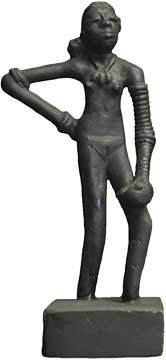Thejaswi Shivanand
The history of civilization rests on the foundation of naturally occuring chemicals that allowed these centres of human endeavour, prodigy, power and intrigue to flourish and spread throughout the ancient world. If we look around us, the societies that built these civilizations have had a lasting impact on our world. How did the first people extract iron from its ore? How did it transform their lives? These are some questions that one could ask of iron and its role in society then, and now. Were chemicals just symbols of technological progress – did they not shape the representation of human creativity in other ways, through art forms such as painting and sculpture? What does history tell us about chemistry, and chemistry about history? Behind each question is a fascinating story, and since history is a record of stories of human ingenuity and frailty, chemistry has a lot to say about history.
 Lost wax and pillars – technology and chemistry
Lost wax and pillars – technology and chemistry
In 1926, a small statuette was excavated from the ruins of the ancient city of Mohenjo-Daro near the river Indus. The statuette was estimated to be 4,500 years old and made entirely of bronze. This statue, speculated to be of a ‘dancing girl’, was considered a considerable find as it predated similar statues from 4th century Greece by some three thousand years.
The statuette had metallurgical fame as well; it was made of bronze, an alloy of copper and tin, mostly copper with about 10-12% tin. Bronze was already well-known in the ancient world and the oldest bronze objects date from c.4000 B.C. from current day Iran and China. The intriguing aspect of this statue was that it was cast in a single mold. It was the earliest example of a metallurgical process called lost-wax casting. In this process, the artist first makes a wax model of a sculpture. A plaster outer mold is then made around the original wax model. This hollow plaster model can be used to make hollow wax molds by repeatedly pouring small amounts of wax into the hollow and moving it about, allowing the wax to coat the inner surface of the mold to a desired thickness. The two pieces of hollow wax are then joined together, coated with metal or alloy powder and fired in a kiln. The wax melts or burns out (‘lost wax’) and a hollow metal sculpture is left behind. This process allows full statues to be cast without the need for welded joints and easy replication is made possible. This technological innovation of the Indus people continues to be in use across the world today. The Indus people also used bronze in making various other objects, including arrowheads, spears, and household objects. Pure copper objects that lacked arsenic impurities were excavated in Lothal in current day Gujarat – more evidence that the Indus people were technically fairly advanced in copper metallurgy.
The author is a part of Centre for Learning, Bengaluru. He teaches and learns in various areas including nature walks, biology, statistics and environmental science. He is interested in travel, music and reading. He can be reached at dumaketu@gmail.com.
